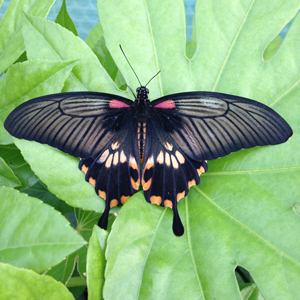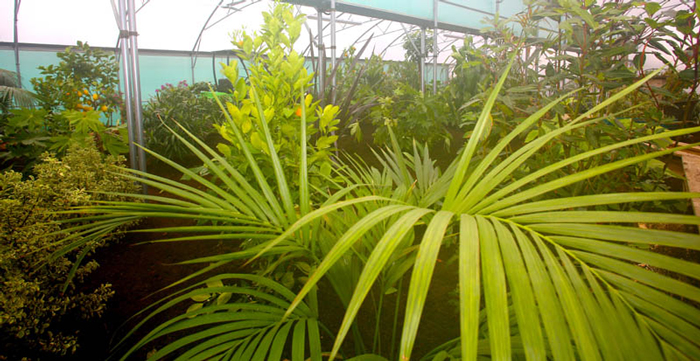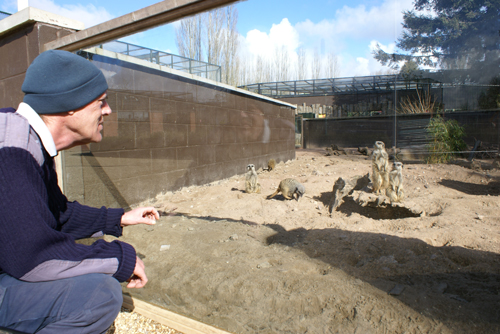All in a day’s work for zoo gardeners
When we visit a zoo it is perhaps easy to forget that just like any other environment and landscape, it requires gardeners too. Graham Eyre is Horticultural Manager at Twycross Zoo, one of the UK’s major zoos and a World Primate Centre and Reckless Gardener recently asked him just what the job of a zoo gardener entails.
I was certainly in for a surprise to discover the breadth of experience needed to work as a horticulturist in this type of environment. As one might expect, there are lawns and car parks to mow and maintain, hedges to cut and beds to plant but gardeners at Twycross also have to look after the maintenance of animal enclosures and the Twycross Zoo Nature Reserve as well. Then there is the tropical Butterfly House and the herb garden, not to mention the ponds and reed beds!
Graham is assisted by four gardeners who are all kept busy with the 88 acres the Zoo covers. As Graham points out: “I cannot think of a better place to work, there is so much variety in the requirements of different parts of the site.”
 The Nature Reserve itself consists of 19 ponds that treat the waste water coming from the Zoo’s Himalaya visitor centre. The first five of these ponds are reed beds that treat the water and the following ponds are for ‘settlement’, which means that after passing through them the water is clear as well as clean.
The Nature Reserve itself consists of 19 ponds that treat the waste water coming from the Zoo’s Himalaya visitor centre. The first five of these ponds are reed beds that treat the water and the following ponds are for ‘settlement’, which means that after passing through them the water is clear as well as clean.
To keep the reed beds healthy, Graham and his team need to ensure that they are regularly cut, with about a third cut back every year. It is a time consuming job but well worth the effort.
The Nature Reserve provides a local wetland habitat, which is important as in the UK there is only around 5% of the original wetland remaining. There is also an ancient hedgerow, several hundred years old, and a meadow area. Graham points out that the aim is to encourage local species to find a home at the zoo while providing a peaceful place with lots of birds and butterflies in the summer.
Spring is particularly busy for the team as they need to ensure the bedding plants start going out around the site: “Every day I will meet with my team and we will discuss what we will be working on,” says Graham. “Sometimes we will all be working on the same area, other times we will split up to work on smaller projects. There is always plenty of work to be done as we now have some brilliantly planted animal enclosures.”
The zoo’s Butterfly Forest is a walk-through exhibit that has lots of tropical plants for the butterflies and visitors alike. Graham is pleased with the planting scheme here with many of the plants thriving.
“I am very proud of the end result, except for one thing … as a gardener, the last thing you want all over your new plants is caterpillars munching away,” says Graham. “You can often see our giant owl butterfly caterpillars chewing through the canna plants. It is a delicate balance to replace the eaten plants, keeping the Butterfly Forest at its best, and provide the caterpillars with the food they need. However, it is worth it to see the joy on the children’s faces as they walk around surrounded by fluttering butterflies (and it is excellent that the butterflies like the plants so much that they are happy to breed).”
The building and heating system at Twycross Zoo’s tropical Buttrerfly House has been designed to enable easy maintenance of the environment at 28 degrees centigrade. Plants in the tropical house are selected for their ability to survive at this desired temperature, their tropical appearance and their ability to supply butterfly lifecycles.
(pictured above: Graham with the Meerkats)
There are over 30 plant species including agapanthus, callistemon, kumkwat, lemon and orange trees, japonicas, phormiums, canna, yucca, hibiscus and ficus.
Graham explained that herbs are also grown at the zoo. The herb garden contains thyme, sage, parsley, rosemary and coriander and these are enjoyed by a number of species including the Colobus monkeys and Rupert the zoo’s iguana! Herbs are also used for animal enrichment – rubbing scents throughout animals’ enclosures for them to investigate.
Graham admits that one of the best things about working at Twycross Zoo is being around the different animals with his favourite being the meerkats.
As horticulture manager he also has to support the animal keepers by supplying different animals with browse. Many of the plants around the site are regularly cut for browse, which is mostly hawthorn, fruit trees, bramble, poplar and birch. The browse is used by almost every animal in the zoo and in particular the Asian elephhants, chimpanzees and leaf eating monkeys. It will also be enjoyed by the zoo’s upcoming new residents, the giraffes.
Which just goes to show that a gardener’s life can be a varied one especially if you work in a zoo.
For more information on Twycross Zoo log onto: www.twycrosszoo.org
Picture credits: ©Twycross Zoo



